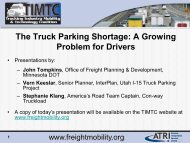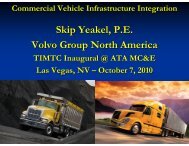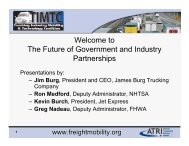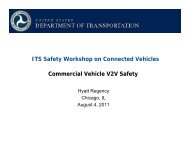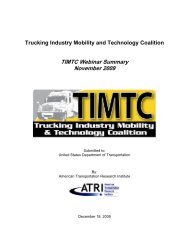Meeting Summary (pdf) - Trucking Industry Mobility and Technology ...
Meeting Summary (pdf) - Trucking Industry Mobility and Technology ...
Meeting Summary (pdf) - Trucking Industry Mobility and Technology ...
You also want an ePaper? Increase the reach of your titles
YUMPU automatically turns print PDFs into web optimized ePapers that Google loves.
<strong>Trucking</strong> <strong>Industry</strong> <strong>Mobility</strong> <strong>and</strong><br />
<strong>Technology</strong> Coalition<br />
Annual <strong>Meeting</strong> <strong>Summary</strong><br />
Submitted to:<br />
The United States Department of Transportation<br />
By:<br />
The American Transportation Research Institute<br />
November 2011<br />
950 N. Glebe Road, Suite 210<br />
Arlington, Virginia 22203<br />
www.atri-online.org
TRUCKING INDUSTRY MOBILITY AND TECHNOLOGY COALITION<br />
2011 ANNUAL MEETING<br />
Gaylord Texan Resort <strong>and</strong> Convention Center<br />
October 17-18, 2011<br />
This report outlines the events that occurred at the Third Annual <strong>Meeting</strong> of the <strong>Trucking</strong><br />
<strong>Industry</strong> <strong>Mobility</strong> <strong>and</strong> <strong>Technology</strong> Coalition (TIMTC), held on October 17-18, 2011. The TIMTC<br />
annual meeting was once again held in conjunction with the American <strong>Trucking</strong> Associations’<br />
(ATA) Management Conference <strong>and</strong> Exhibition (MC&E) at the Gaylord Texan Resort <strong>and</strong><br />
Convention Center in Grapevine, Texas. This year, 77 individuals pre-registered for the<br />
meeting, compared with 66 for the 2010 annual meeting. However, over 200 people<br />
participated in the annual meeting sessions.<br />
Three sessions comprised the third annual meeting:<br />
1. Educational Session: (Data) Mining for Gold: Using Your Driver Data to Reduce Crashes<br />
2. TIMTC Annual <strong>Meeting</strong>: The Future of Government <strong>and</strong> <strong>Industry</strong> Partnerships<br />
3. TIMTC Annual <strong>Meeting</strong>: A Day in the Life of a Connected Truck<br />
TIMTC also had the opportunity to set up an XM/Sirius radio show booth to highlight speakers<br />
<strong>and</strong> critical issues from the annual meeting. The Dave Nemo Show broadcast live on October<br />
17 <strong>and</strong> 18 for two hours each morning on topics ranging from the transportation reauthorization<br />
bill to increasing productivity in the trucking industry.<br />
Summaries of each of the three sessions <strong>and</strong> the two Dave Nemo Show broadcasts follow.<br />
Dave Nemo Show Broadcast<br />
Monday, October 17<br />
8:00 – 10:00 a.m.<br />
Anne Ferro, FMCSA Administrator, <strong>and</strong> Dan Murray, ATRI Vice President, Research<br />
Administrator Ferro kicked-off the first show with an update on several FMCSA initiatives,<br />
including hour-of-service (HOS) <strong>and</strong> electronic on-board recorder (EOBR) rulemaking, the<br />
proposed CMV cell phone use while driving ban <strong>and</strong> changes to CSA.<br />
Jim Burg, James Burg <strong>Trucking</strong> Company President <strong>and</strong> CEO, <strong>and</strong> Kevin Burch, Jet Express<br />
President<br />
Mr. Burg <strong>and</strong> Mr. Burch discussed the industry’s experience with government collaborations<br />
as well as their perspective on the future of government <strong>and</strong> industry partnerships. They<br />
also provided several examples of programs/technologies that may need to be m<strong>and</strong>ated<br />
(e.g. EOBRs to “level the playing field”) <strong>and</strong> programs/technologies that are better left for<br />
voluntary adoption. Mr. Burg also stressed the need for the protection of sensitive data.<br />
Major Ron Cordova, New Mexico DPS, <strong>and</strong> John Hill, Former FMCSA Administrator <strong>and</strong> the Hill<br />
Group Principal<br />
<strong>Trucking</strong> <strong>Industry</strong> <strong>Mobility</strong> <strong>and</strong> <strong>Technology</strong> Coalition – 2011 Annual <strong>Meeting</strong> <strong>Summary</strong> 2
Major Cordova spoke about the New Mexico Department of Public Safety’s enforcement<br />
activities. These efforts have been able to focus on non-compliant carriers through<br />
technology such as wireless roadside inspections (WRI), automated license plate<br />
readers <strong>and</strong> automated U.S. DOT number recognition system. The use of these<br />
technologies is the most cost-effective <strong>and</strong> efficient method for identifying the noncompliant<br />
carriers. Mr. Hill provided comments on nationwide highway safety initiatives<br />
such as the U.S. DOT-sponsored Smart Roadside Initiative (SRI).<br />
Doug Hathaway, Maxum Specialty Insurance Group Vice President, Transportation Division,<br />
<strong>and</strong> Dan Murray, ATRI Vice President, Research<br />
Mr. Hathaway discussed what types of driver <strong>and</strong> carrier data are being used by the<br />
insurance industry as well as some of the benefits <strong>and</strong> challenges associated with the<br />
predictive modeling. This type of modeling allows enforcement activities to be focused<br />
on the small percentage of drivers/carriers that are responsible for the majority of<br />
accidents.<br />
(Data) Mining for Gold: Using Your Driver Data to Reduce Crashes<br />
Monday, October 17<br />
2:30 – 4:00 p.m.<br />
Approximate attendance: 140<br />
Moderated by Dan Murray, ATRI Vice President, Research<br />
Anne Ferro, FMCSA Administrator<br />
Many of Administrator Ferro’s comments centered on FMCSA’s Compliance, Safety,<br />
Accountability initiative. This program represents a more efficient <strong>and</strong> effective use of<br />
data than the previous SafeStat system. The data loop generated by this system<br />
connects drivers with motor carrier management staff as well as enforcement personnel.<br />
Administrator Ferro cited the importance of in-cab naturalistic studies to improve<br />
highway safety. FMCSA <strong>and</strong> the Virginia Tech Transportation Institute (VTTI) have<br />
produced a website that utilizes video clips captured during such a naturalistic study.<br />
The videos show examples of driver errors <strong>and</strong> provide valuable driving tips. Fleet<br />
safety managers are encouraged to use this website as part of their driver training<br />
programs. (www.fmcsa.dot.gov/about/outreach/education/driverTips/index.htm)<br />
Chad Engl<strong>and</strong>, C.R. Engl<strong>and</strong> COO<br />
C.R. Engl<strong>and</strong> collects a large amount of driver safety data to use in their predictive<br />
modeling scenarios. These algorithms can be used to predict a driver’s future safety<br />
performance, fatigue levels, driver retention <strong>and</strong> can also assist the company in the<br />
recruiting process by assessing a driver’s work history.<br />
For example, in order to assess future safety performance, C.R. Engl<strong>and</strong> evaluates<br />
changes in the length of hauls, differences in the number of hard brakes, empty miles<br />
compared to the fleet average, time spent idling <strong>and</strong> the number of days since a<br />
vacation.<br />
<strong>Trucking</strong> <strong>Industry</strong> <strong>Mobility</strong> <strong>and</strong> <strong>Technology</strong> Coalition – 2011 Annual <strong>Meeting</strong> <strong>Summary</strong> 3
By utilizing these analyses, C.R. Engl<strong>and</strong> is able to focus resources on the drivers<br />
deemed most likely to have an accident in the upcoming month. This system also<br />
generates “action plans” for carriers based on the driver’s behavior in the previous<br />
month.<br />
These predictive models have provided the insight to more effectively manage drivers.<br />
From 2009 to 2010, C.R. Engl<strong>and</strong> had a 32 percent decrease in accidents, an 81<br />
percent decrease in accident severity, a 17 percent decrease in driver turnover <strong>and</strong> a 24<br />
percent increase in driver productivity.<br />
Major Ron Cordova, New Mexico Department of Public Safety<br />
The New Mexico Department of Public Safety (NM DPS), Motor Transportation Police,<br />
has improved highway safety recently through the implementation of several intelligent<br />
transportation systems (ITS) as part of the Smart Roadside Initiative (SRI). These<br />
include automated license plate recognition systems <strong>and</strong> automated U.S. DOT number<br />
recognition systems.<br />
The NM DPS also established twelve “safety corridors” where crashes frequently<br />
occurred. These corridors have reduced speed limits, double fines for traffic violations<br />
<strong>and</strong> increased law enforcement presence. Additionally, the NM DPS has incorporated<br />
an internal performance-based system for managing enforcement by specific crash<br />
types, driver behaviors <strong>and</strong> locations.<br />
The NM DPS has partnered with the industry to educate drivers about large trucks <strong>and</strong><br />
also participates in the “Teens <strong>and</strong> Trucks” program.<br />
Doug Hathaway, Maxum Specialty Insurance Group Vice President, Transportation Division<br />
Mr. Hathaway has been using driver data analyses since finding that 9 out of ten drivers<br />
involved in an accident had a violation on their Motor Vehicle Record (MVR) or were new<br />
entrant drivers. Many motor carriers have very limited resources <strong>and</strong> predictive<br />
modeling <strong>and</strong> other analyses offer a way to focus those resources on the drivers most<br />
likely to be involved in a crash. He also noted that a very small percent of drivers are<br />
involved in the vast majority of incidents.<br />
Mr. Hathaway also stressed the importance of using this data to improve driving<br />
behaviors. He <strong>and</strong> many other industry stakeholders have found this data valuable <strong>and</strong><br />
would like to see more motor carriers install <strong>and</strong> utilize the various technologies currently<br />
available. Toward this end, a tax incentive should be offered to carriers as an added<br />
incentive to implement the safety systems.<br />
Questions <strong>and</strong> comments<br />
The Q&A portion of the session began with a question about a potential nationwide ban<br />
on cell phone use while driving. Administrator Ferro stated that one of the main goals of<br />
the U.S. DOT is to educate people on the dangers of driving distracted. In 2010,<br />
FMCSA issued a rule prohibiting commercial motor vehicle (CMV) drivers from texting<br />
while driving <strong>and</strong> is planning to propose an additional ban on h<strong>and</strong> held cell phone use in<br />
<strong>Trucking</strong> <strong>Industry</strong> <strong>Mobility</strong> <strong>and</strong> <strong>Technology</strong> Coalition – 2011 Annual <strong>Meeting</strong> <strong>Summary</strong> 4
the future. The Administrator noted the need for additional research on the effects of<br />
h<strong>and</strong>-free communication devices.<br />
A second question was addressed to the Administrator, this time asking what could be<br />
done about carriers who “reincarnate.” Administrator Ferro replied that FMCSA would<br />
like to implement a nationwide vetting system similar to the drug <strong>and</strong> alcohol<br />
clearinghouse which would be able to search for <strong>and</strong> identify applicants with information<br />
already in the system.<br />
Another participant asked Mr. Engl<strong>and</strong> about the return-on-investment (ROI) of the<br />
predictive modeling system that C.R. Engl<strong>and</strong> uses. He answered that while the capitol<br />
invested was not tremendous, the amount of time that it took to implement was greater<br />
than expected. He also noted, however, that saving a life is priceless.<br />
Dave Nemo Show Broadcast<br />
Tuesday, October 18<br />
8:00 – 10:00 a.m.<br />
John Hill, Former FMCSA Administrator <strong>and</strong> the Hill Group Principal <strong>and</strong> Dan Murray, ATRI Vice<br />
President, Research<br />
Mr. Hill <strong>and</strong> Mr. Murray discussed a myriad of topics, including the need for more safety<br />
system ROI information, whether safety enforcement activities are targeting the right<br />
drivers, vehicles <strong>and</strong> carriers, the status of the HOS revisions <strong>and</strong> the driver shortage<br />
issue.<br />
Chris Flanigan, FMCSA <strong>and</strong> Rebecca Brewster, ATRI President <strong>and</strong> COO<br />
Mr. Flanigan joined Ms. Brewster on the air to discuss the status of Wireless Roadside<br />
Inspection research <strong>and</strong> how carriers will be impacted.<br />
Dan Murray, ATRI Vice President, Research <strong>and</strong> Rebecca Brewster, ATRI President <strong>and</strong> COO<br />
Mr. Murray <strong>and</strong> Ms. Brewster spoke about several ongoing ATRI research initiatives<br />
including mapping truck rollover locations, real-time weather notification systems <strong>and</strong> the<br />
identification of freight bottlenecks.<br />
Bill Graves, ATA President <strong>and</strong> CEO<br />
Mr. Graves provided his views on the future of the highway reauthorization bill <strong>and</strong> the<br />
pros <strong>and</strong> cons of potential funding sources (mileage-based user fees versus increased<br />
fuel taxes). He also noted the critical role that research <strong>and</strong> data plays in developing<br />
<strong>and</strong> supporting highway infrastructure investments.<br />
John Runyan, Coalition for Transportation Productivity Executive Director <strong>and</strong> Darrin Roth, ATA<br />
Director of Highway Operations<br />
Mr. Runyan <strong>and</strong> Mr. Roth spoke about the need for increased weight limits for trucks in<br />
the U.S. <strong>and</strong> the Safe <strong>and</strong> Efficient Transportation Act (SETA).<br />
<strong>Trucking</strong> <strong>Industry</strong> <strong>Mobility</strong> <strong>and</strong> <strong>Technology</strong> Coalition – 2011 Annual <strong>Meeting</strong> <strong>Summary</strong> 5
TIMTC Annual <strong>Meeting</strong>: The Future of Government <strong>and</strong> <strong>Industry</strong> Partnerships<br />
Tuesday, October 18<br />
10:15 – 11:30 a.m.<br />
Approximate attendance: 65<br />
Moderated by John Hill, Former FMCSA Administrator <strong>and</strong> the Hill Group Principal<br />
Jim Burg, James Burg <strong>Trucking</strong> Company President <strong>and</strong> CEO<br />
Mr. Burg stressed the importance of safety investments for fleets. James Burg <strong>Trucking</strong><br />
has made substantial investments in equipment (tire inflation system, roll <strong>and</strong> stability<br />
control systems, collision mitigation systems, cargo securement pins, lane departure<br />
warning systems <strong>and</strong> video event recorders), their drivers (above average pay <strong>and</strong><br />
benefits, training <strong>and</strong> re-training programs <strong>and</strong> hiring experienced drivers) <strong>and</strong><br />
maintenance shops (efficient bays <strong>and</strong> significant parts inventory <strong>and</strong> performance<br />
based brake testing machines).<br />
Many of the safety technologies can also be partnered with other technology to improve<br />
efficiency. For example, James Burg <strong>Trucking</strong> combined a tire inflation system with<br />
single-wide tires. This reduced the weight of each unit by 2,200 pounds <strong>and</strong> increased<br />
payload by up to 30 percent. While safety is a key component of business operations,<br />
efficiency <strong>and</strong> productivity are vital as well.<br />
Since it is anticipated that enforcement resources will continue to be reduced in the<br />
future, the most effective <strong>and</strong> efficient method to improve highway safety will be through<br />
voluntary carrier involvement. Incentives should be developed to increase carrier<br />
participation in these safety programs. It will be critical that all stakeholders be involved<br />
in this collaboration (carriers, government, enforcement, suppliers <strong>and</strong> shippers).<br />
One successful example of a successful voluntary program that will become a m<strong>and</strong>ate<br />
is EPA’s SmartWay program. This program has allowed carriers to experiment with a<br />
wide array of energy saving technologies <strong>and</strong> processes to find what worked best for<br />
their operations <strong>and</strong> the fuel efficiency m<strong>and</strong>ates that will become effective in 2014 will<br />
include many of the successes of the SmartWay program. Mr. Burg suggested that a<br />
similar voluntary program could be implemented to improve safety.<br />
Ron Medford, NHTSA Deputy Administrator<br />
Deputy Administrator Medford discussed the collaborative research that went into the<br />
joint EPA <strong>and</strong> NHTSA fuel economy regulations. NHTSA is also working with industry<br />
partners on several other research projects including the evaluations of stability control<br />
systems, crash avoidance <strong>and</strong> connected vehicle technologies. The Deputy<br />
Administrator stressed the importance of timely, accessible <strong>and</strong> accurate data.<br />
Kevin Burch, Jet Express President<br />
Mr. Burch recounted his recent participation in ATA’s “Call on Washington” program.<br />
This program allows state trucking association members the opportunity to travel to<br />
Washington, D.C. to meet with their members of Congress, agency officials <strong>and</strong> ATA<br />
policy <strong>and</strong> legislative staff. He cited this as an excellent way to be involved in policy<br />
<strong>Trucking</strong> <strong>Industry</strong> <strong>Mobility</strong> <strong>and</strong> <strong>Technology</strong> Coalition – 2011 Annual <strong>Meeting</strong> <strong>Summary</strong> 6
issues <strong>and</strong> to “let your voice be heard.” Mr. Burch also noted that it is important to<br />
become involved with local <strong>and</strong> regional planning committees. These groups are often<br />
directly involved in infrastructure planning. The right combination of infrastructure <strong>and</strong><br />
technologies will allow the trucking industry to flourish.<br />
Greg Nadeau, FHWA Deputy Administrator<br />
FHWA is currently collaborating will several industry stakeholders to improve the safety<br />
<strong>and</strong> performance of the highway transportation system. Data is a critical component of<br />
many of their programs, including the freight performance measures (FPM) initiative.<br />
The goal of these programs is to focus available funding on key freight corridors.<br />
Data is also playing an increasing role in FHWA’s dealing with Congress. Current,<br />
accurate <strong>and</strong> accessible data will be essential for a national freight policy.<br />
Questions <strong>and</strong> comments<br />
The first question was for Mr. Burg concerning load optimization. He replied that James<br />
Burg <strong>Trucking</strong> worked closely with shippers <strong>and</strong> other stakeholders in order to maximize<br />
capacity. He also noted that the company also participated in a very productive<br />
Michigan DOT meeting where they were asked for insight on what the state could do to<br />
improve freight movements.<br />
The next question asked the panel for tips on becoming involved with local government<br />
organizations. Mr. Burch stated that the easiest way to get involved is through local<br />
chambers of commerce <strong>and</strong> media outlets. Carriers should seek out opportunities to<br />
provide positive comments about the industry <strong>and</strong> to enhance its image.<br />
Another audience member asked if there had been any research into connecting the<br />
PrePass/E-ZPass systems to other entities such as shippers, ports, railroads, etc.<br />
Deputy Administrator Nadeau pointed out that SRI is seeking to address some of that<br />
concern by focusing on a comprehensive roadside communication network. He also<br />
noted that while the much of the necessary technology exists, the focus now is on the<br />
ability to rapidly deploy the system.<br />
Finally, the panel was asked if it may be possible to initiate a voluntary safety program<br />
similar to EPA’s SmartWay or the Trusted Truck program. All of the panel members<br />
thought it was a good idea <strong>and</strong> a good opportunity for future collaboration.<br />
TIMTC Annual <strong>Meeting</strong>: A Day in the Life of a Connected Truck<br />
Tuesday, October 18<br />
2:00 – 4:30 p.m.<br />
This session was split into three discussion areas: Increasing <strong>Mobility</strong>, Increasing Productivity<br />
<strong>and</strong> Improving Safety.<br />
Approximate attendance: 60<br />
Discussion facilitator: Kate Hartman, RITA<br />
Increasing <strong>Mobility</strong><br />
<strong>Trucking</strong> <strong>Industry</strong> <strong>Mobility</strong> <strong>and</strong> <strong>Technology</strong> Coalition – 2011 Annual <strong>Meeting</strong> <strong>Summary</strong> 7
Ed Strocko, FHWA<br />
The four main goals of FHWA include building for the future, spurring innovation,<br />
ensuring highway safety <strong>and</strong> reforming government/exercising responsibility. FHWA is<br />
proposing to accomplish this through several actions including consolidating individual<br />
programs into core programs, establishing a performance-based highway program <strong>and</strong><br />
giving states broader flexibility on the use of funds to improve the performance of<br />
designated national freight corridors.<br />
The FY 2012 budget outlines the key elements of a national performance-based<br />
highway program. The focus will initially be on safety, pavement <strong>and</strong> bridge conditions<br />
but will be exp<strong>and</strong>ed to include economic competitiveness, environmental sustainability<br />
<strong>and</strong> livability. Performance measures are being used in planning <strong>and</strong> policy decisions,<br />
forecasting <strong>and</strong> modeling, performance management <strong>and</strong> to communicate results to the<br />
public <strong>and</strong> strengthen accountability. They are also being used to identify <strong>and</strong> define<br />
freight significant corridors on a national level.<br />
Barbara Ivanov, Washington State DOT<br />
The Washington State Legislature initiated the first state truck performance measure<br />
program in the U.S. in 2007. The initial project tracked truck trips through GIS<br />
technology <strong>and</strong> the Washington State DOT (WSDOT) analyzed truck speed <strong>and</strong> travel<br />
time reliability in the central Puget Sound region. The state legislature continues to fund<br />
this program <strong>and</strong> has recently increased their support to $200,000 for the 2011-13<br />
budget.<br />
The freight performance measures program has allowed the state to accurately identify<br />
significant freight bottlenecks <strong>and</strong> to successfully compete for (<strong>and</strong> prioritize) funding. It<br />
has also increased public accountability to citizens. Tracking truck highway performance<br />
before <strong>and</strong> after projects are constructed helps to explain the value of infrastructure<br />
investment.<br />
Ms. Ivanov stressed how essential partnerships with the industry are for this program –<br />
its success depends on retaining access to data owned by trucking companies. These<br />
companies continue to support the program because WSDOT has made protecting their<br />
proprietary data a top priority <strong>and</strong> has used the analyses to improve the states truck<br />
freight system.<br />
R<strong>and</strong>y Butler, FHWA<br />
Mr. Butler provided an overview of dynamic mobility applications (DMA). In order to<br />
address a lack of traveler information, FHWA is developing freight advanced traveler<br />
information (FRATIS) applications focusing on real-time location data, dynamic route<br />
guidance <strong>and</strong> drayage optimization. A pilot test of this system (Cross-Town<br />
Improvement Project) was conducted in Kansas City this summer <strong>and</strong> it was found that<br />
the number of empty trips was reduced significantly during the trial.<br />
Questions <strong>and</strong> comments<br />
One audience member asked Ms. Ivanov if the highway improvement projects<br />
implemented in Washington State were really addressing the congestion issue or if the<br />
<strong>Trucking</strong> <strong>Industry</strong> <strong>Mobility</strong> <strong>and</strong> <strong>Technology</strong> Coalition – 2011 Annual <strong>Meeting</strong> <strong>Summary</strong> 8
traffic levels were just being moved to another corridor. Ms. Ivanov noted that that is a<br />
concern in planning these projects <strong>and</strong> that they must clearly define the goals of each<br />
plan <strong>and</strong> communicate those to the public.<br />
Another participant inquired about the future of the Cross-Town Improvement Project (C-<br />
TIP). Mr. Butler stated that it is expected to become a publically owned <strong>and</strong> operated<br />
system in the future.<br />
Increasing Productivity<br />
Tom Kearney, FHWA<br />
Mr. Kearney gave an update on the Smart Roadside Initiative (SRI). SRI will help<br />
enforcement officials to identify non-compliant carriers while keeping compliant carriers<br />
moving on the highways. The research <strong>and</strong> analysis phase is complete <strong>and</strong> the concept<br />
of operations phase is nearing completion. Next steps will include determining system<br />
requirements <strong>and</strong> designing the system architecture. Ultimately, this initiative will<br />
improve productivity through an integrated <strong>and</strong> interoperable roadside inspection<br />
system.<br />
Chris Flanigan, FMCSA<br />
Wireless roadside inspections (WRI) are one of the core SRI programs. WRI allows<br />
enforcement officials to conduct more inspections since driver, vehicle <strong>and</strong> carrier<br />
checks are performed while the vehicle is moving. This allows the focus to be on unsafe<br />
drivers <strong>and</strong> vehicles, even if they are associated with a “safe” carrier.<br />
Several potential benefits to the industry have been identified. These include reduced<br />
delays, fuel use <strong>and</strong> equipment wear due to fewer stops for roadside inspections <strong>and</strong><br />
lower insurance costs <strong>and</strong> increased transparency due to real-time WRI result sharing<br />
with carriers.<br />
Pilot tests conducted in three different states evaluated the technical <strong>and</strong> operational<br />
feasibility of WRI earlier this year. The tests incorporated EOBRs, fleet management<br />
technologies <strong>and</strong> E-screening systems to check driver qualification <strong>and</strong> log data while<br />
the vehicle traveled at highway speeds. The next phase of research will include a field<br />
operational text <strong>and</strong>, ultimately, a national deployment.<br />
John Runyan, Coalition for Transportation Productivity<br />
The Safe <strong>and</strong> Efficient Transportation Act (SETA) would give states the authority to allow<br />
97,000 pound, 6-axle vehicles interstate access. Mr. Runyan pointed out that the 6 th<br />
axle on a truck maintains essentially the same weight per axle, tire displacement <strong>and</strong><br />
braking distance. The 6 th axle also ensures that there is no additional pavement wear<br />
since there is no additional weight per axle. Increasing the weight limit for trucks could<br />
improve highway safety, reduce emissions <strong>and</strong> increase efficiency.<br />
Questions <strong>and</strong> comments<br />
All of the questions for this panel were about SRI. First, an audience member asked<br />
what the timeline for SRI was <strong>and</strong> if new technology was needed to implement it? Mr.<br />
<strong>Trucking</strong> <strong>Industry</strong> <strong>Mobility</strong> <strong>and</strong> <strong>Technology</strong> Coalition – 2011 Annual <strong>Meeting</strong> <strong>Summary</strong> 9
Kearney replied that most of the technology has been developed at this point <strong>and</strong> that<br />
the next phase should be completed in the next few years. A follow-up question from<br />
the same individual asked if it was going to be a national program <strong>and</strong> if it would be a<br />
voluntary program. It will be a voluntary program <strong>and</strong> Mr. Flanigan pointed out that it is<br />
being planned as a national program in order to be able to identify trends at the corridor,<br />
regional <strong>and</strong> national levels.<br />
Finally, a participant commented that SRI should include other entities such as ports<br />
since there are often no scales to weight cargo containers with. These containers often<br />
get put on trucks which then get an overweight violation<br />
Improving Safety<br />
Bob Petrancosta, Con-way Freight<br />
Mr. Petrancosta provided an update on the connected vehicle safety pilot model<br />
deployment. This is a naturalistic field test of several vehicle-to-vehicle (V2V) <strong>and</strong><br />
vehicle-to-infrastructure (V2I) wireless communication technologies <strong>and</strong> included over<br />
2,200 instrumented vehicles <strong>and</strong> 29 roadside infrastructure locations. The data being<br />
collected will be used to determine the effectiveness of the technologies <strong>and</strong> ensure that<br />
they do not distract the drivers.<br />
The pilot test has three levels of vehicle/technology integration: 1. fully integrated<br />
(EOBRs send/receive messages, multiple safety applications <strong>and</strong> driver feedback from<br />
the technology); 2. retro-fit (aftermarket installation) <strong>and</strong> 3. vehicle awareness device<br />
(broadcasts only a basic safety message <strong>and</strong> no driver feedback). Con-way is one of<br />
the carriers participating in this project. It will not only benefit them in the future through<br />
fully vetted <strong>and</strong> interoperable technologies but also assists Con-way now through access<br />
to data captured through these experiments.<br />
Chris Flanigan, FHWA<br />
Mr. Flanigan provided an overview of FMCSA ITS initiatives on behalf of Jon Mueller.<br />
The initiatives include both technology transfer activities (CMV Roadside <strong>Technology</strong><br />
Corridor <strong>and</strong> the FAST DASH program) as well as roadside <strong>and</strong> onboard technology<br />
deployments (CVISN <strong>and</strong> promotion of existing onboard safety system benefits).<br />
FHWA has several roadside technology initiatives underway. These include an app<br />
(Query Central Mobile) that will allow FMCSA border <strong>and</strong> state inspectors to access<br />
motor carrier safety scores from an iPhone or iPad.<br />
Bob Kreeb, NHTSA<br />
NHTSA is currently focusing research on crash mitigation systems such as electronic<br />
control systems to improve highway safety. These systems enhance lateral vehicle<br />
stability by electronically assisting drivers in dangerous situations. The mitigation<br />
systems improve safety through driver warnings <strong>and</strong>, if the driver does not take steps to<br />
address the situation, active vehicle control. These systems can also improve safety<br />
through driver performance monitoring.<br />
Questions <strong>and</strong> comments<br />
<strong>Trucking</strong> <strong>Industry</strong> <strong>Mobility</strong> <strong>and</strong> <strong>Technology</strong> Coalition – 2011 Annual <strong>Meeting</strong> <strong>Summary</strong> 10
An audience member inquired about the possibility of truck platooning with these<br />
technologies. Mr. Kreeb noted that the California PATH coalition demonstrated the<br />
feasibility of this approximately 10 years ago <strong>and</strong> more recently in France but there are<br />
currently no plans for truck platooning in the U.S.<br />
<strong>Trucking</strong> <strong>Industry</strong> <strong>Mobility</strong> <strong>and</strong> <strong>Technology</strong> Coalition – 2011 Annual <strong>Meeting</strong> <strong>Summary</strong> 11
Appendix A:<br />
TIMTC 2011 Annual <strong>Meeting</strong> Agenda<br />
<strong>Trucking</strong> <strong>Industry</strong> <strong>Mobility</strong> <strong>and</strong> <strong>Technology</strong> Coalition – 2011 Annual <strong>Meeting</strong> <strong>Summary</strong> 12
<strong>Trucking</strong> <strong>Industry</strong> <strong>Mobility</strong> <strong>and</strong> <strong>Technology</strong> Coalition – 2011 Annual <strong>Meeting</strong> <strong>Summary</strong> 13



